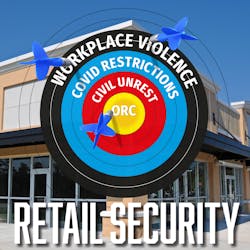This article originally appeared as the cover story in the July 2021 issue of Security Business magazine. When sharing, don’t forget to mention Security Business magazine on LinkedIn and @SecBusinessMag on Twitter.
When analyzing a vertical market’s security needs, talk inevitably turns to the proverbial “what keeps you up at night” question. As trusted advisors and technology experts, security integrators must be cognizant of the biggest and newest challenges in order to create a solution that delivers exactly what is expected.
The problem for the retail vertical is that nobody is quite sure what the next security challenge will be. Yes, there are staples like loss prevention, access control and video surveillance that will always be hallmarks of retail security operation, but when the security dynamic changes in North America, retailers are most often the first to know – and toIt isn’t hard to imagine burning and looted retail locations when an incident drives Americans to civil unrest. While most people think of the healthcare market first when it comes to workplace violence, retail operators see violent incidents in their workplaces – often with deadly consequences – on an all-too-regular basis. Many retail operations remained open during the first weeks of massive COVID restrictions. The list goes on.
Thus, in your quest as integrators to identify the major pain points for your retail customers and offer viable solutions, here are the four biggest issues based on recent events in America:
1. COVID
As noted, retailers – especially grocers and big box stores – remained open throughout the pandemic and all its restrictions, including social distancing, mask enforcement and capacity restrictions. Many of these organizations deployed video analytic solutions to address these challenges.
As the country slowly marches toward vaccination and a return to “normalcy,” retailers should be looking to these analytic technologies to further enhance their operations.
“Software is going from just pure data visualization to now having analytics behind it,” explained Rhett Asher, VP of Strategy for ThinkLP, a provider of a loss prevention, safety and business management software platform for retailers, during a recent webinar conducted by the Loss Prevention Foundation. “(With so many) data sources – employee files, store location data, POS data, SKU files, HR data, shipping and receiving data – the more data you pull together, you really get this kind of holistic look at your organization, and (you can understand) the risk ranking in all of these different areas and then what do you do about it.”
Another obvious byproduct of the pandemic fallout for retailers is a massive increase in e-commerce. “Buy online and pick up in-store and buy online pick up curbside were developing, but (the pandemic) accelerated it exponentially,” Hedgie Bartol, Retail Business Development Manager at Axis Communications, said in the same LPF webinar. “We are going to see those trends continue, but I don't think that all of a sudden, this year is going to be the death of brick-and-mortar retail. Actually because of the experience that people have had over the past year, it is driving people back to brick-and-mortar, (because) they don't enjoy getting something that they were not able to try on or actually look at and waiting for however long for it to be delivered.”
2. Organized Retail Crime
The rise of e-commerce and curbside pickup that exploded with the pandemic has coincided with an established threat in the retail space, Organized Retail Crime (ORC); however, the days of rogue actors infiltrating a retail establishment to target items like laundry detergent, baby formula and over-the-counter medicine evolved with the rise in e-commerce.
“When (pandemic-related closures) happened, these people needed to figure out what they were going to do,” explained John Goldyn, Senior Director of Loss Prevention for retailer ULTA Beauty, during a session at the National Retail Federation (NRF)’s recent Retail Converge event. “They started to investigate the online opportunity.”
For those stores that remained open during the pandemic, ORC gangs exploited curbside pickup and other online-grounded opportunities. They also began targeting new types of products. Todd Isenhour, a Division Director for Asset Protection, Operations and Safety for Lowe's, explained during the NRF event: “What we began to see at Lowe's was a shift from the traditional products that (ORC) groups typically targeted – power equipment and tools – to pandemic-related items like safety-related supplies and cleaning supplies.”
Loss prevention technology continues to play a key role in combatting ORC as brick-and-mortar locations have reopened. According to Jack L. Hayes International's 33rd annual Retail Theft Survey, the average shoplifting case value in 2020 was $310.11, an increase of 13% from 2019 ($274.40).
“While temporary store closures due to the pandemic resulted in fewer thieves being caught stealing in 2020, the average shoplifting case value increased,” explains Mark R. Doyle, President of Jack L. Hayes Intl. “As expected, the pandemic clearly affected apprehensions and recovery dollars in 2020, with shoplifting apprehensions and recovery dollars down 43.8% and 36.5% respectively.”
3. Workplace Violence
Much like healthcare and school verticals, being on the front lines of America means dealing with all sorts of workplace violence. Despite closures, the pandemic, again, brought a lot of this violence to the surface.
In March, a mass shooting occurred at a King Soopers supermarket in Boulder, Colo., where 10 people were killed, including a local on-duty police officer. Recently in June, a triple shooting at a grocery store in an Atlanta suburb left a cashier dead and a deputy and the gunman injured. The incident allegedly started when the cashier asked the shooter to put on a mask.
“With the sharp rise in gun violence across the country, it is essential for the retail industry to work more closely with local law enforcement and seek out new technologies so they can be better prepared to respond quickly if an incident arises,” Paul Mascari, Director of Security Solutions at gunshot detection provider ShotSpotter, said in a recent press release.
Beyond gun-related incidents, the focus on pandemic-related enforcement, as well as an overall spike in violence just because of the situation has led retail security directors to reassess employee training and de-escalation methods.
“We have noticed an uptick in situations that turn into safety risks, so we have started to concentrate our efforts on helping (employees) deal with escalated customer situations,” Kevin Stone, Manager of Organized Retail Crime for Columbia Sportswear Co., said during the NRF event. “We are helping our teams navigate how to deal with people that exhibit disruptive type of behaviors.”
While specific technology may not be brought to bear on this problem, security integrators can certainly leverage their role as trusted security subject matter experts to help retail customers. Look to organizations such as the Crisis Prevention Institute (http://crisisprevention.com) to help with providing de-escalation techniques that can be shared.
4. Civil Unrest
Riots and civil unrest are long-standing pain points for retail establishments, and while some of these incidents remain fresh in the collective minds of Americans, it is the only issue here that is decidedly not pandemic-related.
“I think we are in for a pretty rough summer,” warned Dr. Larry Barton during his NRF Retail Converge session. Dr. Barton is a threat and risk consultant and a Distinguished Professor of Crisis Management and Public Safety for University of Central Florida. “We are going to see more riots, more civil unrest –more people stirring the pot for whatever reason.”
Security professionals in any vertical or related service can benefit by understanding of the causes, warning signs and behavioral dynamics of large crowds and mobs that can be correlated with protests and riots.
“Certainly, after we saw that initial wave of rioting and violence, we saw some organizations take more proactive steps to just sort of shut down operations or board up windows in advance of dates that were expected to prompt unrest,” says Allison Wood, who leads Control Risks’ political risk consulting practice in the U.S. and Canada. “Of course, these types of solutions are costly and disruptive to retailers. What we have seen is a combination of security teams working to ensure that store managers and employees know how to respond in cases of civil unrest but also to try and use analysis and intelligence to understand where these protests are likely to happen so they can be as prepared as possible.”
Social media monitoring is one service that security integrators can incorporate into their retail solutions. Software providers such as Signal Corp. (http://getsignal.info) can efficiently monitor the entirety of the surface, deep, and dark web in real time to provide early warning of potential threats and incidents. This can be an invaluable tool for retailers as well as other vertical customers such as public venues, schools and more.
Paul Rothman is Editor-in-Chief of Security Business magazine. Email him your comments and questions at [email protected]. Access the current issue, full archives and apply for a free subscription at www.securitybusinessmag.com.










